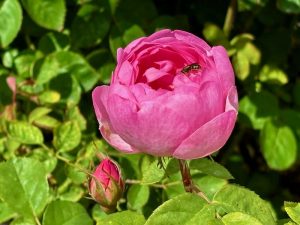Rosa ‘Skylark’: A Breezy, Fragrant English Shrub Rose
Rosa ‘Skylark’ or Rose ‘Skylark’ is a compact and charming English shrub rose bred by David Austin in the United Kingdom. First introduced in 2007, this cultivar is part of the celebrated English Rose Collection and carries the breeder code ‘AUSimple.’ Known for its clusters of cupped, mid-pink blooms, ‘Skylark’ offers a light musk and tea fragrance that adds subtle charm to any garden. The flowers open with a fresh, deep pink tone and gradually fade to a soft lilac-pink, revealing a white center and golden stamens. Its tidy habit and continuous bloom cycle make it a versatile and rewarding choice for gardeners seeking a reliable, fragrant rose.
Rosa ‘Skylark’ belongs to the Rosaceae family, a vast group that includes many ornamental and fruit-bearing plants. The family is known for its diversity, resilience, and horticultural value. As a hybrid shrub rose, ‘Skylark’ shares lineage with both traditional old garden roses and modern hybrids, combining classic bloom form with strong disease resistance and long flowering seasons.
Growth Habit and Appearance
This shrub stays neat and bushy, reaching about 90 cm (3 feet) in height and spreading roughly 70 cm (28 inches). Its growth is light and airy, developing into a rounded form that fits well in mixed borders, containers, or rose-specific plantings. The foliage is dark green, semi-glossy, and healthy, providing a perfect backdrop for the delicate flowers. Despite its modest size, ‘Skylark’ produces bloom clusters with impressive regularity from late spring until the first frost.
Each flower measures about 7 cm (2.75 inches) in diameter and boasts over 40 petals, arranged in a full, cupped, old-fashioned style. The blooms appear in small, relaxed clusters and are particularly attractive to pollinators. While the scent is not overpowering, the blend of apple, clove, musk, and tea notes makes ‘Skylark’ subtly aromatic and pleasing to the senses.
How to Grow Rosa ‘Skylark’
Light
‘Skylark’ thrives in full sun, needing at least six hours of direct light each day. It tolerates partial shade but may produce fewer blooms if light is limited. For best results, plant it in an open area with good airflow and consistent sun exposure.
Soil
This rose prefers fertile, well-drained soil with a slightly acidic pH between 6.0 and 7.0. Incorporate compost or aged manure before planting to boost organic matter and drainage. In heavy or poorly draining soils, consider planting in raised beds or large containers filled with a humus-rich mix.
Watering
Water deeply and consistently, especially during the first growing season. Once established, ‘Skylark’ tolerates brief dry spells, but regular watering helps maintain its bloom cycle. Always water at the base to avoid wetting the foliage, which can lead to fungal issues.
Fertilizing
Apply a balanced rose fertilizer in early spring, just as new growth appears. Reapply after the first major flush of blooms, and again in midsummer if needed. Avoid high-nitrogen feeds, which encourage leaf growth at the expense of flowers. Organic mulches and composted manure also support steady, healthy growth.
Pruning
In late winter or early spring, prune out dead, damaged, or crossing canes. Lightly shape the shrub by cutting back no more than one-third of the plant. Prune to outward-facing buds to promote an open structure and reduce disease pressure. Regular deadheading encourages more blooms and prevents energy going into hip production, though this cultivar rarely sets hips.
Pests and Diseases
Rosa ‘Skylark’ shows good resistance to common rose diseases like black spot and mildew. Still, monitor regularly for aphids, spider mites, and caterpillars. Improve airflow with proper spacing and pruning, and remove fallen or diseased leaves to reduce fungal risk. If needed, treat infestations with insecticidal soap or horticultural oil.
Propagation
Propagate ‘Skylark’ by hardwood cuttings in autumn or chip budding in summer. You can also take softwood cuttings in spring and root them in moist, well-draining media under cover. Grafted plants on vigorous rootstocks may perform better in poor soils or colder zones.
Landscape Uses
Thanks to its size and rounded shape, ‘Skylark’ fits beautifully in mixed borders, cottage gardens, and container arrangements. Its cool pink coloring harmonizes well with blue-flowered companions like Salvia, Nepeta, and lavender. It performs especially well in small gardens or formal rose beds. It’s also an excellent cut flower, adding charm and fragrance to indoor arrangements.
Hardiness and Climate
‘Skylark’ grows best in USDA zones 6b through 9b and tolerates a range of conditions. With some winter mulch or protection, it may survive in colder zones as well. It handles hot summers if given enough water and airflow, and its sturdy nature makes it a reliable performer even in less-than-perfect settings.
Final Notes on Rosa ‘Skylark’
Rosa ‘Skylark’ offers the hallmarks of David Austin’s breeding vision—classic beauty, fragrance, and modern practicality. With its modest size, light scent, and near-constant flowering habit, this rose is a fine choice for both novice and experienced gardeners. Whether nestled among perennials or showcased in a pot, ‘Skylark’ delivers consistent charm season after season.



